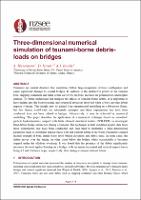| dc.description.abstract | Tsunamis are natural disasters that sometimes follow large-magnitude offshore earthquakes and cause significant damage to coastal bridges. In addition to the destructive power of the tsunami bore, shipping containers and other debris carried by the bore, increase the potential for catastrophic damage. To better understand and mitigate the effects of tsunami-borne debris, it is important to have insight into the hydrodynamic and structural processes involved when a bore carrying debris impacts a bridge. This insight may be gained from experimental modelling in a laboratory flume, but few flumes world-wide are adequately equipped and those experiments that have been conducted have not been related to bridges. Alternatively, it may be achieved by numerical modelling. This paper describes the application of a numerical technique based on smoothed-particle hydrodynamics coupled with finite element structural models (SPH-FEM) to investigate fluid-debris-bridge interaction during a tsunami. The technique is first validated against data from those experiments that have been conducted, and then used to undertake a three-dimensional parameter study to determine impact forces with and without debris in the water. Parameters studied include strength of bore, initial water level, bridge elevation, and debris mass. In some cases, the debris moves over the bridge, in other cases below the bridge, while occasionally it becomes trapped under the offshore overhang. It was found that the presence of the debris significantly increased the total applied loading on the bridge, with the mean horizontal and vertical impact forces being 4.2 and 2.6 times larger, respectively, compared to cases without debris. | |

